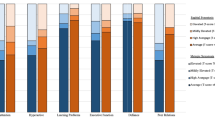Abstract
The psychosocial development of 20 adolescents with congenital paralysis due to myelodysplasia is compared to 20 age- and gender-matched subjects with no physical handicap. On many of the measures the myelodysplasia group showed poorer adjustment and lower self-esteem than the controls. Consistent with hypotheses regarding adjustment during adolescence the paralyzed males did show greater concern on Offer's scales of Body and Self-Image and External Mastery and showed poorer adjustment on his Sexual Attitudes Scale. The paralyzed girls, particularly those 13 years or younger, showed the poorest emotional adjustment with a significant variability in responses on many of the tests. This degree of variability may indicate a lack of integration of self-concepts and is consistent with an emotional immaturity discordant with advanced physiologic maturation of these girls.
Similar content being viewed by others
References
Briggs, P. F., and Marquette, C. H. (1972). Intellectual and emotional development. InModern Management of Myelomeningocele. Warren H. Green, Inc., St. Louis, pp. 210–229.
Brocklehurst, G. (ed.) (1976).Spina Bifida for the Clinician, Clinics in Developmental Medicine No. 57, Spastics International Medicine Publications, J. B. Lippincott Co., Philadelphia.
Campbell, M. M., and Cooper, K. (1975). Parents' perception of adolescent behavior problems.J. Youth Adoles. 4: 309–320.
Dorner, S. (1974). Some problems of families with an adolescent spina bifida patient.Dev. Med. Child. Neuro. Suppl. 32: 153.
Dorner, S. (1975) Relationship of physical handicap in families with an adolescent with spina bifida.Dev. Med. Child. Neurol. 17: 765–776.
Evans, K., Hickman V., and Carter, C. O. (1974). Handicap and social status of adults with spina bifida.Brit. J. Prev. Soc. Med. 28: 85–92.
Fitts, W. J. (1965).Tennessee Self Concept Scale Manual, Counselor Recordings and Tests, Nashville, Tenn.
Lanyon, R. I. (1968).Psychological Screening Inventory Manual, Research Psychologists Press, Goshen, N. Y.
Lorber, J., and Schloss, A. L. (1973). The adolescent with meningomyelocele.Dev. Med. Child. Neurol. Suppl. 29: 113–114.
MacKeith, R. (1973). The feelings and behavior of parents of handicapped children.Dev. Med. Child. Neurol. 15: 524.
Michigan State Department of Mental Health (1953).The Michigan Picture Test, Science Research Associates. Chicago.
Offer, D. (1971).The Offer Self-Image Questionnaire for Adolescents Manual, Rev., Institute for Psychosomatic and Psychiatric Research and Training, Michael Reese Hospital, Chicago.
Offer, D., and Howard, K. I. (1972). An empirical analysis of the Offer Self-Image Questionnaire for Adolescents.Arch. Gen. Psychiat. 27: 529–533.
Rotter, J. B., and Rafferty, J. E. (1950).Rotter Incomplete Sentences Blank Manual. Psychological Corporation, New York.
Shurtleff, D. B., Hayden, P. W., Chapman, W. H., Broy, A. B., and Hill, M. L. (1975). Myelodysplasia: Problems of long-term survival and social function.West. J. Med. 122: 199–205.
Sousa, J. C., Gordon, L. H., and Shurteleff D. B. (1976). Assessing the development of daily living skills in patients with spina bifida.Dev. Med. Child. Neurol. Suppl. 37: 134–142.
Symonds Picture Story Test Manual. (1948). Bureau of Publications, Teacher's College, Columbia University, New York.
Tanner, J. M. (1962).Growth of Adolescence, Blackwell Scientific Publications, London, pp. 32–37.
Tew, B.J., and Laurencs, K. M. (1972). The ability and attainments of spina bifida patients born in South Wales between 1956–1962.Dev. Med. Child. Neurol. Suppl. 27: 124–131.
Wahler, H. J. (1971).Wahler Self-Description Inventory Manual. Western Psychological Services, Los Angeles.
Author information
Authors and Affiliations
Additional information
This study was supported in part by the National Foundation-March of Dimes.
Received her Ph.D. from the University of Washington in 1959. Main interests are adolescent development, personality, and evaluative research.
Received her M.D. from the University of Rochester, New York, in 1953 and her pediatrics training at Children's Hospital, Los Angeles. Main interests are comprehensive care of patients with birth defects; research and management of hydrocephalus.
Received her M.D. from McGill University in 1968 and her pediatric training at University of Washington, Seattle. Main interest is care of children with handicapping conditions, with emphasis on communication problems of the hearing impaired.
Rights and permissions
About this article
Cite this article
Campbell, M.M., Hayden, P.W. & Davenport, S.L.H. Psychological adjustment of adolescents with myelodysplasia. J Youth Adolescence 6, 397–407 (1977). https://doi.org/10.1007/BF02139241
Received:
Issue Date:
DOI: https://doi.org/10.1007/BF02139241



